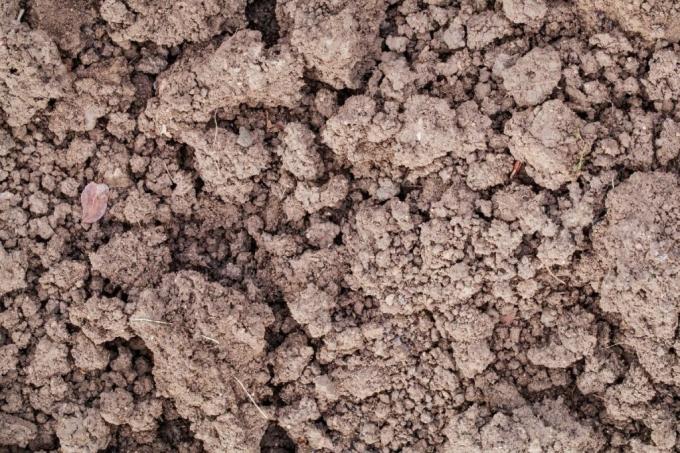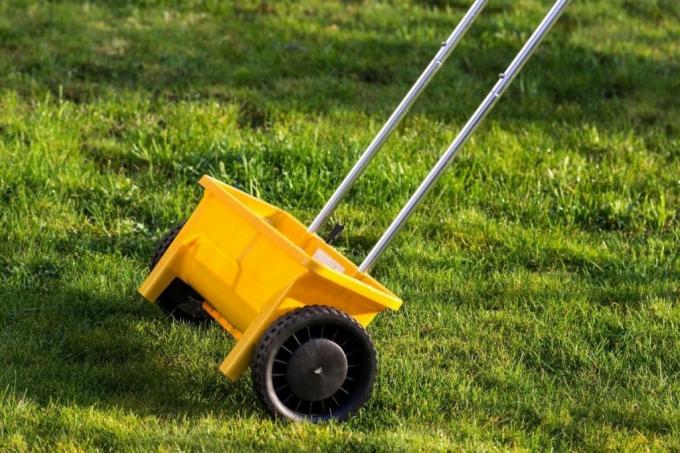
table of contents
- Determine soil type
- Drainage and loosening
- Improvement through plants
- Instructions for soil improvement
- sand
- Soil activator
- lime
- Bentonite
- Lawn fertilizer
- Biochar
- Clay minerals
- frequently asked Questions
race is generally considered to be easy to care for. But the magnificent green does not always meet your own requirements. Below you will learn more about soil improvement for the lawn.
In a nutshell
- for a targeted improvement you should determine the type of soil
- Depending on the soil structure, different measures are suitable for soil improvement
- Drainage and loosening can make the soil more permeable
- Popular means of optimizing the soil are sand, clay minerals, lawn fertilizers, lime or biochar
Determine soil type
In order to choose the ideal soil improvement measures for your lawn, you should first determine the soil. After all, sandy, loam and clay soils are widespread in our regions. With a simple test you can check what type of soil it is. To do this, take soil in your hand and try to form a ball:
- Sandy soil: soil is granular and crumbly
- Clay soil: the ball holds and the earth does not stick
- Clay soil: sticky structure and shiny

Soil structure
Plant organisms, animal components and humus shape the soil structure. At the same time, there are minerals that arise from a parent rock in the earth. This significantly influences the type of soil. The soil structure is shaped by the cavities that determine the type of subsoil. At the same time, they influence the relationship between air and water.
Composition of the soil
A good garden soil should consist of a successful mixture of different components. Water and air play an elementary role. At the same time, the garden soil should contain various nutrients so that the plants can thrive. A mixture of sand, clay, humus and loam is considered to be beneficial for the plants. With certain additives, hobby gardeners can further improve the soil so that the composition is optimal for lawn growth.
Drainage and loosening
Simple measures for improving the soil for your lawn are drainage and loosening. If water builds up in the ground, it can negatively affect the lawn soil. So you should loosen up the compacted soil again and again. If this is not possible, you should create a drainage. The water seeps through a layer of sand or gravel and flows off through the pipes.
Note: If you are not confident in laying drainage, landscapers will be happy to help.

Improvement through plants
Plants are ideal for improving the soil for the lawn. The soil should never be unplanted. You can stimulate the soil with green manure plants. These plants root through the soil and release the nutrients. Then it is the best time to sow the lawn seeds. In principle, the following green manure plants are suitable:
- peas
- Lupins
- Winter rye
- alfalfa
Instructions for soil improvement
Anyone who deals with the subject of soil improvement comes across various possibilities. Below are a number of measures that can be taken to improve the quality of the soil.
sand
One way of improving the soil for the lawn is to sand it. This measure ensures that the soil becomes more permeable. Preferably bring in the sand after scarifying in spring. Before doing this, you should mow the sand. Fine sand, sandy loam soil, or quartz sand are all equally suitable for improving the soil.
Note: Particularly hard clay soils can withstand another treatment with sand in autumn.
Soil activator
With a Soil activator loose and hard soils can be supplied. It is a type of stone meal that contains concentrated humus. In addition, the lime it contains increases the pH value in the soil. This improves the soil structure. The application of the soil activator in connection with a lawn fertilizer is particularly recommended. This procedure is suitable for sandy and clay soils.

Tip: The longer the lawn has not been fertilized, the more often you should apply the soil activator.
lime
Lime is ideal for raising the pH level in the soil. However, hobby gardeners shouldn't start liming. Rather, it is advisable to test the pH value beforehand. If clay soil is rich in humus, lime can loosen this soil.
Bentonite
Betonite is a natural mineral that stores water and nutrients. The powder or granules are suitable for sandy soils, which you then water. Soil improvement with Betonit is recommended every one to two years.
Lawn fertilizer
Lawn fertilizer is another means that helps in improving the soil structure. Lawn and soil receive all the important nutrients. At the same time, high-quality products have an effect of up to six months. The first fertilization should be done in spring, when the soil is slowly getting warmer.

Biochar
Biochar is a modern means of improving the soil in the garden. The carbon creates the basis for further building up of humus. Spreading the biochar is a good way to improve the soil in an organic way.
Clay minerals
Clay is common in soils. It's a tiny mineral that stores nutrients and water. Sandy soils are ideal for the use of clay minerals.
frequently asked Questions
When you renovate the lawn, you can count on green sprouting much earlier. The existing grasses offer protection for the newcomers. The germinating grasses then grow under the protection of the existing plants. You can use the lawn again after 6-8 weeks.
Humus is crucial for high quality soil. Basically, you can buy ready-made humus and put it in the soil. Regular checking of pH, soil temperature and nutrient intake can be responsible for a beautiful lawn.
The soil improvement measures help ensure that the lawn flourishes. Nevertheless, you can have a decisive influence on the quality of the lawn if you choose the right and resistant types of lawn that suit the local conditions.



